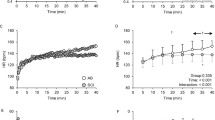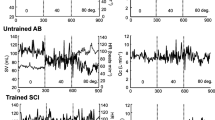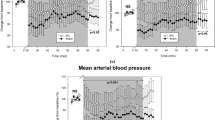Abstract
The purpose of this study was to determine the effect of passive leg cycle exercise (PLE) on cardiovascular and respiratory responses in people with spinal cord injuries (PSCI). Eight PSCI with lesions from T8 to L1 and five control subjects (CS) performed PLE at pedalling frequencies of 20 or 40 rpm for 7 min at room temperature of about 25°C. We measured, at rest and during PLE, the pulmonary ventilation (VE), oxygen uptake (VO2), cardiac output (Q), stroke volume (SV), heart rate (HR) and arterial blood pressure, as well as the skin blood flow (SBF) in the lower limb after PLE. An increase in pedalling frequency promoted an increase in VE and VO2 in both groups. Compared with the CS, the PSCI showed significantly smaller increases in VO2 (P < 0.05). The Qc was significantly elevated during PLE at 20 and 40 rpm in CS, and at 40 rpm in PSCI (P < 0.05). In CS, it resulted from increases in both SV and HR, whereas in PSCI, it was contributed to by a greater increase in SV without a rise in HR. In CS, the increase in pedalling frequency promoted the increases in SV and HR and consequently in Qc In PSCI, however, the values remained constant irrespective of pedalling frequency. The arterial blood pressure and SBF in the lower limbs were unchanged by PLE in both groups. These results would suggest that passive leg exercise promotes venous return from the paralyzed lower limbs in PSCI.
Similar content being viewed by others
References
Adams L, Cross BA, Frankel H, Furneax R, Garlick J, Guz A, Murphy K, Semple SJG (1980a) Effect of spinal cord transection in the ventilatory response to electrically induced exercise in the anaesthetised dog. J Physiol (Lond) 308:66P
Adams L, Cross BA, Frankel H, Furneax R, Garlick J, Guz A, Murphy K, Semple SJG (1980b) The dynamics of the ventilatory response to voluntary and electrically induced exercise in man: the influence of the spinal cord. J Physiol (Lond) 310:67P
Bahnson ER, Horvath SM, Comroe JH Jr (1949) Effects of active and ‘passive’ limb movements upon respiration and O2 consumption in man. J Appl Physiol 2:169–173
Benjamin FB, Peyser L (1964) Physiological effects of active and passive exercise. J Appl Physiol 16:1212–1214
Comroe JH, Schmidt CF (1943) Reflexes from the limbs as a factor in the hyperpnea of muscular exercise. Am J Physiol 138:536–547
Cross BA, Davey A, Guz A, Katona PG, Maclean M, Murphy K, Semple SJG, Stidwill R (1982) The role of spinal cord transmission in the ventilatory response to electrically induced exercise in the anaesthetised dog. J Physiol (Lond) 329:37–55
Davis GM (1993) Exercise capacity of individuals with paraplegia. Med Sci Sports Exerc 25:423–432
Davis GM, Servedio FJ, Glaser RM, Gupta SC, Suryaprasad AG (1990) Cardiovascular responses to arm-cranking and FNS-induced leg exercise in paraplegics. J App] Physiol 69:671–677
Fuhrer MJ, Garber SL, Rintala DH, Clearman R, Hart KA (1993) Pressure ulcers in community-resident persons with spinal cord injury: prevalence and risk factors. Arch Phys Med Rehabil 74:1172–1177
Figoni SF (1993) Exercise responses and quadriplegia. Med Sci Sports Exerc 25:433–441
Figoni SF, Davis GM, Glaser RM, Servedio FJ, Gupta SC, Suryaprasad AG, Rodgers MM, Ezenwa BN (1988) FNS-Assisted venous return in exercising. ICAART pp 328–329
Figoni SF, Rodgers MM, Glaser RM, Hooker SP, Feghri PD, Ezenwa BN, Mathews T, Suryaprasad AG, Gupta SC (1990) Physiologic responses of paraplegics and quadriplegics to passive and active leg cycle ergometry. J Am Paraplegia Soc 13:33–39
Grodins FS (1950) Analysis of factors concerned in regulation of breathing in exercise. Physiol Rev 30:220–239
Hida W, Shindoh Y, Kikuchi Y, Chonan T, Inoue H, Sakai H, Takishima T (1986) Ventilatory response to phasic contraction and passive movement in graded anesthesia. J App] Physiol 61:91–97
Hooker SP, Greenwood JD, Boyd LA, Hodges MR, McCune LD, McKenna GE (1993) Influence of posture on arm exercise tolerance and physiologic responses in persons with spinal cord injured paraplegia. Eur J Appl Physiol 67:563–566
Hopman MTE (1994) Circulatory responses during arm exercise in individuals with paraplegia. Int J Sports Med 15:126–131
Hopman MTE, Oeseburg B, Binkhorst RA (1992) The effect of an anti-G suit on cardiovascular responses to exercise in persons with paraplegia. Med Sci Sports Exerc 24:984–990
Hopman MTE, Kamerbeek ICE, Pistorius M, Binkhorst RA (1993a) The effect of an anti-G suit on the maximal performance of individuals with paraplegia. Int J Sports Med 14:357–361
Hopman MTE, Verheijen PHE, Binkhorst RA (1993b) Volume changes in the legs of paraplegic subjects during arm exercise. J Appl Physiol 75:2079–2083
Jaeger-Denavit O, Lancert P, Grossiord A (1973) Study of ventilatory response to passive movement of the legs in paraplegics. Bull Pathol Physiol Respir 9:709–710
Johnson JM, Taylor WF, Shepherd AP, Park MK (1984) Laser Doppler measurement of skin blood flow: comparison with plethysmography. J Appl Physiol 56:798–803
Kinzer SM, Convertino VA (1989) Role of leg vasculature in the cardiovascular response to arm work in wheelchair-dependent population. Clin Physiol 9:525–533
Mathias CJ, Frankel HL (1988) Cardiovascular control in spinal man. Ann Rev Physiol 50:577–592
McLean KP, Jones PP, Skinner JS (1995) Exercise prescription for sitting and supine exercise in subjects with quadriplegia. Med Sci Sports Exerc 27:15–21
Morikawa T, Ono Y, Sasaki Y, Sakakibara Y, Yanaka Y, Maruyama R, Nishibayashi Y, Honda Y (1989) Afferent and cardiodynamic drives in the early phase of exercise hyperpnea in humans. J Appl Physiol 67:2006–2013
Muraki S, Yamasaki M, Ishii K, Kikuchi K, Seki K (1995) Effect of arm cranking exercise on skin blood flow of lower limb in people with injuries to the spinal cord. Eur J Appl Physiol 71:28–32
Muraki S, Yamasaki M, Ishii K, Kikuchi K, Seki K (1996) The relationship between core temperature and skin blood flow in lower limbs during prolonged arm exercise in persons with spinal cord injury. Eur J Appl Physiol 72:330–334
Nakazono Y, Miyamoto Y (1985) Cardiorespiratory dynamics in men in response to passive work. Jpn J Physiol 35:33–43
Nash MS, Bilsker MS, Kearney HM, Ramirez JN, Applegate B, Green BA (1995) Effects of electrically-stimulated exercise and passive motion on echocardiographically-derived wall motion and cardiodynamic function in tetraplegic persons. Paraplegia 33:80–89
Nobrega ACL, Williamson JW, Freidman DB, Araujo CGS, Mitchell JH (1994) Cardiovascular responses to active and passive cycling movements. Med Sci Sports Exerc 26:709–714
Otis AB (1949) Application of Gray's theory of respiratory control to the hyperpnea produced by passive movements of the limbs. J App] Physiol 1:743–751
Pitetti KH, Barrett PJ, Campbell KD, Malzahn DE (1994) The effect of lower body positive pressure on the exercise capacity of individuals with spinal cord injury. Med Sci Sports Exerc 26:463–468
Russo AK, Tarasantchi J, Griggio MA (1977) Oxygen consumption and ventilation of dogs during passive and active exercise. J Appl Physiol 42:923–927
Saumet JL, Kellogg DL Jr, Taylor WF, Johnson JM (1988) Cutaneous laser-Doppler flowmetry: influence of underlying muscle blood flow. J Appl Physiol 65:478–481
Waisbren SJ, Whiting CS, Nadel ER (1990) Effects of passive limb movement on pulmonary ventilation. Yale J Biol Med 63:549–556
Wasserman K, Whipp BJ, Castagna J (1974) Cardiodynamic hyperpnea: hyperpnea secondary to cardiac output increase. J Appl Physiol 36:457–464
Weissman ML, Jones PW, Oren A, Lamarra N, Whipp BJ, Wasserman K (1982) Cardiac output increase and gas exchange at start of exercise. J Appl Physiol 52:236–244
Yamasaki M, Komura T, Fujiie K, Sasaki H, Kai K (1994a) Are there benefits of sports participation in the prevention of pressure sores in spinal cord injured persons? Jpn Phys Fitness Sports Med 43:121–126
Yamasaki M, Komura T, Fujiie K, Sasaki H, Kai K, Ohdoko K (1994b) Development of pressure sores in active and inactive persons with spinal cord injury. In: Yabe K, Kusano K, Nakata H (eds) Adapted physical activity. Springer Berlin Heidelberg, New York, Tokyo, pp 62–67
Author information
Authors and Affiliations
Rights and permissions
About this article
Cite this article
Muraki, S., Yamasaki, M., Ehara, Y. et al. Cardiovascular and respiratory responses to passive leg cycle exercise in people with spinal cord injuries. Europ. J. Appl. Physiol. 74, 23–28 (1996). https://doi.org/10.1007/BF00376490
Accepted:
Issue Date:
DOI: https://doi.org/10.1007/BF00376490




